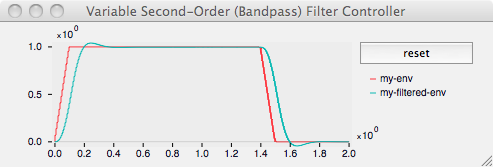Variable Second Order (Bandpass) Filter
Filters its inputs by a second order IIR filter with a variable center frequency and bandwidth.

'variable-second-order-filter
(make-controller 'variable-second-order-filter dimension period input_controller cf-controller bw-controller)
The 'variable-second-order-filter controller takes five arguments:
- dimension: number of dimensions of the input and output controllers.
- period: the time between the updates of the controller. If zero is given then it updates every sample.
- input_controller: filter input (a controller).
- cf-controller: controller specifying the center frequency in Hz.
- bw-controller: controller specifying the bandwidth in Hz.
The number of dimensions should be the same as that of the input controller.
The center frequency and bandwidth parameters should both be controllers. Note that there is no amplitude controller for this filter. Amplitude gain is internally set to 1, but resonances caused by very narrow bandwidths could result in very high amplitude values.
The variable second order (bandpass) filter can be used for a variety of purposes, but generally is used either to smooth out envelopes or create resonances from impulses. Using a low frequency and fairly wide bandwidth, it can smooth out envelopes (a graph of this example is shown in the image, above):
(setq my-env (make-controller 'envelope 1 '((0 0.0) (0.1 1.0) (1.4 1) (1.5 0)) ))
(setq my-filtered-env (make-controller 'variable-second-order-filter 1 0 my-env (const 1) (const 5)))
Or it can be used to add a resonance to an impulse or other noisy sound, by using a specific frequency and a very narrow bandwidth:
(setq my-noise (make-controller 'noise 1 0 (list (const 44100) (const 0.25) (const 0.25) (const 1) (const 1)) 10))
(setq my-filtered-noise (make-controller 'variable-second-order-filter 1 0 my-noise (const 440) (const 1)))
We actually recommend using the more general-purpose 'biquadratic-filter controller instead of this older filter. However, to do so you will need to generate your own filter coefficients (whereas this filer lets you use higher-level parameters like frequency and bandwidth).
Options
There are no special options for this controller.
Modalys Tutorial Example [examples coming soon!]
- Modalys
- Summary
- An Introduction to Modalys
- Objects
- Accesses
- Connections
- Controllers
- Constant Controller
- Envelope Controller
- Access Speed Controller
- Access Position Controller
- Access Force Controller
- Connection State Controller
- Last Sample Controller
- Sound File Controller
- MIDI File Controller
- Dynamic Controller
- Send Message
- Set Breakpoint
- Signal Controller
- Scale Controller
- Arithmetic Controller
- Expression Controller
- Foreign-Call Controller
- Sine Controller
- Random Controller
- Band-Limited Noise Controller
- Noise (Band-Limited Impulse) Controller
- Delay Controller
- Bilinear (First Order IIR) Filter
- Biquadratic (Second Order IIR) Filter
- Constant Second Order (Bandpass) Filter
- Variable Second Order (Bandpass) Filter
- Dimension-Mapping Controller
- Sum Controller
- Spread Controller
- (get-info 'value ... )
- The Modalys Workspace
- Appendix
